The Drivers and Barriers of Renewable Energy Applications and Development in Uganda: A Review
Abstract
:1. Introduction
2. The Status Quo of Renewable Energy Technologies in Uganda
2.1. Peat
2.2. Wind Energy
2.3. Solar Energy
2.4. Geothermal Energy
2.5. Hydroelectric Energy
2.5.1. Large-Scale Hydropower
2.5.2. Small- and Medium-Scale Hydropower
2.6. Biomass Energy
2.7. Biomass Cogeneration
3. The Motivations and Barriers to Renewable Energy Applications and Development in Uganda
3.1. Drivers for Renewable Energy Development in Uganda
3.1.1. Energy Demand
3.1.2. Reduction of CO2 Emission/Footprint
3.1.3. Energy Sector Reforms
3.1.4. Energy Security and Access for Rural Electrification
3.1.5. The Need for Employment Generation
3.1.6. Economic Impact
3.1.7. Energy Efficiency
3.1.8. Feed-in-Tariffs
3.2. Major Barriers and Challenges of Renewable Energy Development in Uganda
3.2.1. Lack of Information and Public Awareness
3.2.2. Huge Initial Investment Cost
3.2.3. High Operation and Maintenance Cost
3.2.4. Inadequate Attention to Research and Development
3.2.5. Lack of Human Capacity & Training
3.2.6. Grid Unreliability
3.2.7. Ineffectual Quality Control of Products
3.2.8. Institutional Barriers
4. Efficient Measures and Policies Required in Overcoming Barriers to Renewable Energy Development in Uganda
4.1. Alleviation of Political and Regulatory Investment Risk
4.2. Energy Subsidy Transfer and Cost Reduction Measures
4.3. Favorable Feed-in-Tariffs Policies
4.4. Consistent Information and Technology Awareness Creation
4.5. Establishment and Enforcement of Quality Standards for Renewable Energy Technologies Equipment
5. Conclusions
Author Contributions
Conflicts of Interest
References
- Review Report on Uganda’s Readiness for the Implementation of Agenda 2030. Available online: https://sustainabledevelopment.un.org/content/documents/10689Uganda%20Review%20Report_CDs1.pdf (accessed on 12 March 2016).
- Istituto Afari Internazionali (IAI); European Centre for Development Policy Management (ECDPM). A New EU Strategic Approach to Global Development, Resilience and Sustainability; IAI Working Papers 16 (14); IAI: Rome, Italy, May 2016; ISSN 2280-4331. ISBN 978-88-98650-94-1. [Google Scholar]
- UN Africa-Sustainable Development Knowledge Platform “Implementation of the United Nations Convention to Combat Desertification in Those Countries Experiencing Serious Drought and/or Desertification, Particularly in Africa: Report of the Second Committee” (A/70/472/Add.5), 14 December 2015. Available online: http://www.un.org/ga/search/view_doc.asp?symbol=A/70/472/Add.5&Lang=E (accessed on 12 March 2016).
- UN General Assembly, Transforming Our World: The 2030 Agenda for Sustainable Development (A/RES/70/1). 25 September 2015. Available online: http://undocs.org/A/RES/70/1 (accessed on 12 June 2017).
- Emodi, N.V.; Boo, K. Sustainable Energy Development in Nigeria: Overcoming Energy Poverty. Int. J. Energy Econ. Policy 2015, 5, 580–597. [Google Scholar]
- Ebohon, O.J. Energy, economic growth and causality in developing countries: A case study of Tanzania and Nigeria. Energy Policy 1996, 24, 447–453. [Google Scholar] [CrossRef]
- Omer, A.M. Energy, environment and sustainable development. Renew. Sustain. Energy 2008, 12, 2265–2300. [Google Scholar] [CrossRef]
- Dincer, I. Renewable energy and sustainable development: A crucial review. Renew. Sustain. Energy 2000, 4, 157–175. [Google Scholar] [CrossRef]
- Kanagawa, M.; Nakata, T. Analysis of the energy access improvement and its socio-economic impacts in rural areas of developing countries. Ecol. Econ. 2007, 62, 319–329. [Google Scholar] [CrossRef]
- Kanagawa, M.; Nakata, T. Assessment of access to electricity and the socio-economic impacts in rural areas of developing countries. Energy Policy 2008, 36, 2016–2029. [Google Scholar] [CrossRef]
- Jiang, Z.; Lin, B. China’s energy demand and its characteristics in the industrialization and urbanization process. Energy Policy 2012, 49, 608–615. [Google Scholar] [CrossRef]
- Jones, D.W. How urbanization affects energy-use in developing countries. Energy Policy 1991, 19, 621–630. [Google Scholar] [CrossRef]
- Jones, D.W. Urbanization and energy use in economic development. Energy J. 1991, 10, 29–44. [Google Scholar] [CrossRef]
- Rasul, G. Managing the food, water, and energy nexus for achieving the Sustainable Development Goals in South Asia. Environ. Dev. 2016, 18, 14–25. [Google Scholar] [CrossRef]
- Colombo, E.; Masera, D.; Bologna, S. Renewable energies to promote local development. In Renewable Energy for Unleashing Sustainable Development; Springer: Cham, Switzerland, 2013; pp. 3–25. [Google Scholar]
- Akenji, L.; Bengtsson, M. Making sustainable consumption and production the core of sustainable development goals. Sustainability 2014, 6, 513–529. [Google Scholar] [CrossRef]
- Shaaban, M.; Petinrin, J.O. Renewable energy potentials in Nigeria: Meeting rural energy needs. Renew. Sustain. Energy Rev. 2014, 29, 72–84. [Google Scholar] [CrossRef]
- Subedi, M.; Matthews, R.; Pogson, M.; Abegaz, A.; Balana, B.; Oyesiku-blakemore, J.; Smith, J. Can biogas digesters help to reduce deforestation in Africa? Biomass Bioenergy 2014, 70, 1–12. [Google Scholar] [CrossRef]
- Deichmann, U.; Meisner, C.; Murray, S.; Wheeler, D. The economics of renewable energy expansion in rural Sub-Saharan Africa. Energy Policy 2011, 39, 215–227. [Google Scholar] [CrossRef]
- Mohammed, Y.S.; Mustafa, M.W.; Bashir, N. Status of renewable energy consumption and developmental challenges in Sub-Sahara Africa. Renew. Sustain. Energy Rev. 2013, 27, 453–463. [Google Scholar] [CrossRef]
- Mohammed, Y.S.; Mokhtar, A.S.; Bashir, N.; Saidur, R. An overview of agricultural biomass for decentralized rural energy in Ghana. Renew. Sustain. Energy Rev. 2013, 20, 15–25. [Google Scholar] [CrossRef]
- Nfah, E.M.; Ngundam, J.M.; Vandenbergh, M.; Schmid, J. Simulation of off-grid generation options for remote villages in Cameroon. Renew. Energy 2008, 33, 1064–1072. [Google Scholar] [CrossRef]
- Suberu, Y.; Bashir, N.; Wazir, M. Overuse of wood-based bioenergy in selected sub-Saharan Africa countries: Review of unconstructive challenges and suggestions. J. Clean. Prod. 2015, 96, 501–519. [Google Scholar]
- Kaunda, CS. Energy situation, potential and application status of small-scale hydropower systems in Malawi. Renew. Sustain. Energy Rev. 2013, 26, 1–19. [Google Scholar] [CrossRef]
- Nzila, C.; Dewulf, J.; Spanjers, H.; Kiriamiti, H.; Van Langenhove, H. Biowaste energy potential in Kenya. Renew. Energy 2010, 35, 2698–2704. [Google Scholar] [CrossRef]
- Kihwele, S.; Hur, K.; Kyaruzi, A. Visions, scenarios and action plans towards next generation Tanzania power system. Energies 2012, 5, 3908–3927. [Google Scholar] [CrossRef]
- Okello, C.; Pindozzi, S.; Faugno, S.; Boccia, L. Bioenergy potential of agricultural and forest residues in Uganda. Biomass Bioenergy 2013, 56, 515–525. [Google Scholar] [CrossRef]
- Kousksou, T.; Allouhi, A.; Belattar, M.; Jamil, A.; El Rhafiki, T.; Arid, A.; Zeraouli, Y. Renewable energy potential and national policy directions for sustainable development in Morocco. Renew. Sustain. Energy Rev. 2015, 47, 46–57. [Google Scholar] [CrossRef]
- Hensley, M.; Gu, S.; Ben, E. A comprehensive review of biomass resources and biofuels potential in Ghana. Renew. Sustain. Energy Rev. 2011, 15, 404–415. [Google Scholar]
- Osei, W.Y.A.W. Rural energy technology: Issues and options for sustainable development in Ghana. Geoforum 1996, 27, 63–74. [Google Scholar] [CrossRef]
- Kiplagat, J.K.; Wang, R.Z.; Li, T.X. Renewable energy in Kenya: Resource potential and status of exploitation. Renew. Sustain. Energy Rev. 2011, 15, 2960–2973. [Google Scholar] [CrossRef]
- Tong, T.M.; Asare, J.; Rwenyagila, E.R.; Anye, V.; Oyewole, O.K; Fashina, A.A.; Soboyejo, W.O. A Study of Factors that Influence the Adoption of Solar Powered Lanterns in a Rural Village in Kenya. Perspect. Glob. Dev. Technol. 2015, 14, 448–491. [Google Scholar] [CrossRef]
- Okello, C.; Pindozzi, S.; Faugno, S.; Boccia, L. Development of bioenergy technologies in Uganda: A review of progress. Renew. Sustain. Energy Rev. 2013, 18, 55–63. [Google Scholar] [CrossRef]
- Nsamba, H.K.; Hale, S.E.; Cornelissen, G.; Bachmann, R.T. Sustainable technologies for small-scale biochar production—A review. J. Sustain. Bioenergy Syst. 2015, 5, 10–31. [Google Scholar] [CrossRef]
- Twaha, S.; Ramli, M.A.; Murphy, P.M.; Mukhtiar, M.U.; Nsamba, H.K. Renewable based distributed generation in Uganda: Resource potential and status of exploitation. Renew. Sustain. Energy Rev. 2016, 57, 786–798. [Google Scholar] [CrossRef]
- Akella, A.K.; Saini, R.P.; Sharma, M.P. Social, economical and environmental impacts of renewable energy systems. Renew. Energy 2009, 34, 390–396. [Google Scholar] [CrossRef]
- Chien, T.; Hu, J.L. Renewable energy: An efficient mechanism to improve GDP. Energy Policy 2008, 36, 3045–3052. [Google Scholar] [CrossRef]
- Sadorsky, P. Renewable energy consumption and income in emerging economies. Energy Policy 2009, 37, 4021–4028. [Google Scholar] [CrossRef]
- BP, P.L.C. BP: Statistical Review of World Energy Workbook (xlsx); BP P.L.C.: London, UK, June, 2017; Available online: https://www.bp.com/content/dam/bp/en/corporate/pdf/energy-economics/statistical-review-2017/bp-statistical-review-of-world-energy-2017-full-report.pdf (accessed on 12 March 2016).
- Energy Information Administration. International Energy Statistics; Retrieved 5 June 2013; Energy Information Administration: Paris, France, 2016. [Google Scholar]
- Karekezi, S. Disseminating renewable energy technologies in sub-Saharan Africa. Annu. Rev. Energy Environ. 1994, 19, 387–421. [Google Scholar] [CrossRef]
- Karekezi, S. Renewables in Africa—Meeting the energy needs of the poor. Energy Policy 2002, 30, 1059–1069. [Google Scholar] [CrossRef]
- Norton Rose Fulbright (NRFC). Investing in the Electricity Sector in Uganda; Norton Rose Fulbright (NRFC): Hong Kong, China, February 2015. [Google Scholar]
- Ministry of Energy and Mineral Development. Strategic Investment Plan 2014/15–2018/19; Ministry of Energy and Mineral Development: Kampala, Uganda, 2014.
- World Bank. Sustainable Energy for All (SE4ALL) Database; from the SE4ALL Global Tracking Framework Led Jointly by the World Bank, International Energy Agency and the Energy Sector Management Assistance Program; World Bank: Washington, DC, USA, 2017. [Google Scholar]
- PWC. Uganda Budget. August 5, 2013 Version. Available online: http://www.pwc.com/en_UG/ug/assets/pdf/uganda-budget-2013.pdf (accessed on 26 February 2017).
- Teke, A.; Timur, O. Assessing the energy efficiency improvement potentials of HVAC systems considering economic and environmental aspects at the hospitals. Renew. Sustain. Energy Rev. 2014, 33, 224–235. [Google Scholar] [CrossRef]
- Drazu, C.; Olweny, M.; Kazoora, G. Household energy use in Uganda: existing sources, consumption, and future challenges. In Living and Learning: Research for a Better Built Environment: 49th International Conference of the Architectural Science Association 2015; Crawford, R.H., Stephan, A., Eds.; The Architectural Science Association of The University of Melbourne: Victoria, Australia, 2015; pp. 352–361. [Google Scholar]
- Luis, D.; Oliveira, D.; Brandao, L.E.; Igrejas, R.; Lima, L. Switching outputs in a bioenergy cogeneration project: A real options approach. Renew. Sustain. Energy Rev. 2014, 36, 74–82. [Google Scholar]
- Muloni, I. Renewable Energy Investment Guide May 2012 Version; Electricity Regulatory Authority: Kampala Uganda, 2012. [Google Scholar]
- GWEC: Global Wind Statistics Report Annual Market Update 2016 Version. Available online: http://www.gwec.net/wp-content/uploads/vip/GWEC_PRstats2016_EN_WEB.pdf (accessed on 26 February 2017).
- Panwar, N.L.; Kaushik, S.C.; Kothari, S. Role of renewable energy sources in environmental protection: A review. Renew. Sustain. Energy Rev. 2011, 15, 1513–1524. [Google Scholar] [CrossRef]
- Association WWE. World Wind Energy Report 2008; WWEA: Bonn, Germany, 2009; Available online: www.wwindea.org/home/images//worldwindenergy report2008 (accessed on 26 February 2017).
- Buchholz, T.; Da Silva, I. Potential of distributed wood-based biopower systems serving basic electricity needs in rural Uganda. Energy Sustain. Dev. 2010, 14, 56–61. [Google Scholar] [CrossRef]
- Center for Energy Efficiency and Renewable Energy. Wind Power: Capacity Factor, Intermittency, and What Happens When the Wind Doesn’t Blow? 2010. Available online: http://www.ceere.org/rerl/about_wind/RERL_Fact_Sheet_2a_Capacity_Factor.pdf (accessed on 26 February 2017).
- Bhutto, A.W.; Bazmi, A.A.; Zahedi, G. Greener energy: Issues and challenges for Pakistan—Wind power prospective. Renew. Sustain. Energy Rev. 2013, 20, 519–538. [Google Scholar] [CrossRef]
- Elistratov, V.V. The development of the wind power industry in Russia. Wind Power World Int. Rev. Dev. 2013, 3, 443. [Google Scholar]
- Dabiri, J.O.; Greer, J.R.; Koseff, J.R.; Moin, P.; Peng, J. A new approach to wind energy: Opportunities and challenges. In Proceedings of the AIP Conference Proceedings, Berkeley, CA, USA, 8–9 March 2014; Volume 1652, pp. 51–57. [Google Scholar]
- Sathaye, J.; Lucon, O.; Rahman, A.; Christensen, J.; Denton, F.; Fujino, J.; Heath, G.; Mirza, M.; Rudnick, H.; Schlaepfer, A.; et al. Renewable Energy in the Context of Sustainable Development; Cambridge University Press: Cambridge, UK, 2011. [Google Scholar]
- Twidell, J.; Weir, T. Renewable Energy Resources; Routledge: Abingdon, UK, 2015. [Google Scholar]
- Karekezi, S.; Kithyoma, W.; Initiative, E. Renewable Energy Development. In Proceedings of the Workshop on African Energy Experts on Operationalizing the NEPAD Energy Initiative, Dakar, Senegal, 2–4 June 2003; pp. 2–4. [Google Scholar]
- Karekezi, S.; Kithyoma, W. Renewable energy strategies for rural Africa: Is a PV-led renewable energy strategy the right approach for providing modern energy to the rural poor of sub-Saharan Africa? Energy Policy 2002, 30, 1071–1086. [Google Scholar] [CrossRef]
- Brew-Hammond, A. Energy access in Africa: Challenges ahead. Energy Policy 2010, 38, 2291–2301. [Google Scholar] [CrossRef]
- Rabah, K.V. Integrated solar energy systems for rural electrification in Kenya. Renew. Energy 2005, 30, 23–42. [Google Scholar] [CrossRef]
- Alazraque-Cherni, J. Renewable energy for rural sustainability in developing countries. Bull. Sci. Technol. Soc. 2008, 28, 105–114. [Google Scholar] [CrossRef]
- Ahuja, D.; Tatsutani, M. Sustainable energy for developing countries. 2009. Available online: http://journals.openedition.org/sapiens/823 (accessed on 6 May 2018).
- Bilgili, M.; Ozbek, A.; Sahin, B.; Kahraman, A. An overview of renewable electric power capacity and progress in new technologies in the world. Renew. Sustain. Energy Rev. 2015, 49, 323–334. [Google Scholar] [CrossRef]
- Kammen, D.M. Solar Cooking for Developing Nations; Harvard University: Cambridge, MA, USA, 1991. [Google Scholar]
- Kammen, D.M. The Kenya Solar Box: Appropriate Dissemination in Africa. In Africa Technology Forum, February/March 1992; African Technology Forum: Cambridge, UK, 1992; Volume 3. [Google Scholar]
- Baanabe, J. Energy supply in Uganda. In Proceedings of the National Workshop on Promoting Sustainable Transport Solutions for East Africa, Nairobi, Kenya, 7–8 August 2012. [Google Scholar]
- Moner-Girona, M.; Ghanadan, R.; Jacobson, A.; Kammen, D.M. Decreasing PV costs in Africa: Opportunities for rural electrification using solar PV in sub-Saharan Africa. Refocus 2006, 7, 40–45. [Google Scholar] [CrossRef]
- Kamese, G. Renewable Energy Technologies in Uganda: The Potential for Geothermal Energy; A Country Study Report under the AFREPREN/HBF Study; Heinrich Boell Foundation: Berlin, Germany, 2004. [Google Scholar]
- Fashina, A.A.; Azeko, S.T.; Asare, J.; Ani, C.J.; Anye, V.C.; Rwenyagila, E.R.; Dandogbesi, B.; Oladele, O.; Dyeris, M. A Study on the Reliability and Performance of Solar Powered Street Lighting Systems. Int. J. Sci. World 2017, 7, 110–118. [Google Scholar] [CrossRef]
- Fashina, A.A.; Adama, K.K.; Oyewole, O.K.; Anye, V.C.; Asare, J.; Zebaze Kana, M.G.; Soboyejo, W.O. Surface Texture and Optical Properties of Crystalline Silicon Substrates. J. Renew. Sustain. Energy 2015, 7, 063119-1–063119-11. [Google Scholar] [CrossRef]
- Hansen, U.E.; Pedersen, M.B.; Nygaard, I. Review of Solar PV Market Development in East Africa; UNEP Risø Centre, Technical University of Denmark: Kongens Lyngby, Denmark, 2014. [Google Scholar]
- Mawejje, J.; Munyambonera, E.; Bategeka, L. Uganda's Electricity Sector Reforms and Institutional Restructuring; Economic Policy Research Centre: Kampala, Uganda, 2012. [Google Scholar]
- Pedersen, M.B. Deconstructing the concept of renewable energy-based mini-grids for rural electrification in East Africa. Wiley Interdiscip. Reviews Energy Environ. 2016, 5, 570–587. [Google Scholar] [CrossRef]
- Renewable Energy & Energy Efficiency Partnership. Renewable Energy Potential in Uganda. Available online: http://www.afribiz.info (accessed on 6 September 2017).
- InfraCo Africa. Kalangala Infrastructure Services. Available online: http://www.infracoafrica.com/projects.asp (accessed on 6 September 2017).
- Folkecenter. Solar Energy in Uganda. Available online: http://www.folkecenter.net (accessed on 6 September 2017).
- Bahati, G. Geothermal Energy in Uganda, Country Update. In Proceedings of the International Geothermal Conference, Reykjavik Iceland, 14–17 September 2003. [Google Scholar]
- Bowen, R. Geothermal Resources; Springer Science & Business Media: Berlin, Germany, 2012. [Google Scholar]
- Glassley, W.E. Geothermal Energy: Renewable Energy and the Environment; CRC Press: Boca Raton, FL, USA, 2014. [Google Scholar]
- Energy Sector GIS Working Group Gets Award for Best Map. Available online: http://www.energyprogramme.or.ug/giz-uganda-gets-award-for-best-gismap/2012 (accessed on 6 September 2017).
- Uganda Bureau of Statistics. Statistical Abstract; Uganda Bureau of Statistics: Entebbe, Uganda, 2013. [Google Scholar]
- Laurea University of Applied Sciences. About Uganda. Available online: https://www.laurea.fi/dokumentit/Documents/Uganda;Country Report.pdf (accessed on 6 September 2017).
- Bartle, A. Hydropower potential and development activities. Energy Policy 2002, 30, 1231–1239. [Google Scholar] [CrossRef]
- Mudoko, S.N. Uganda’s Policy on Energy and Power. Presented at ICA Training on Energy Policy, Tokyo, Japan, 2 June 2013. [Google Scholar]
- UMEME. About UMEME. Available online: http://www.umeme.co.ug/index. php?page¼MTUw (accessed on 6 September 2017).
- McKendry, P. Energy production from biomass (part 1): Overview of biomass. Bioresour. Technol. 2002, 83, 37–46. [Google Scholar] [CrossRef]
- Rittmann, B.E. Opportunities for renewable bioenergy using microorganisms. Biotechnol. Bioeng. 2008, 100, 203–212. [Google Scholar] [CrossRef] [PubMed]
- Karaj, S.; Rehl, T.; Leis, H.; Müller, J. Analysis of biomass residues potential for electrical energy generation in Albania. Renew. Sustain. Energy Rev. 2010, 14, 493–499. [Google Scholar] [CrossRef]
- Demirbaş, A. Biomass resource facilities and biomass conversion processing for fuels and chemicals. Energy Convers. Manag. 2001, 42, 1357–1378. [Google Scholar] [CrossRef]
- Openshaw, K. Biomass energy: Employment generation and its contribution to poverty alleviation. Biomass Bioenergy 2010, 34, 365–378. [Google Scholar] [CrossRef]
- Bingh, LP. Opportunities for Utilizing Waste Biomass for Energy in Uganda. Master’s Thesis, Institutt for Energi-og Prosessteknikk, Trondheim, Norway, 2004. [Google Scholar]
- Khundi, F.; Jagger, P.; Shively, G.; Sserunkuuma, D. Income, poverty and charcoal production in Uganda. For. Policy Econ. 2011, 13, 199–205. [Google Scholar] [CrossRef]
- Kshirsagar, M.P.; Kalamkar, V.R. A comprehensive review on biomass cookstoves and a systematic approach for modern cookstove design. Renew. Sustain. Energy Rev. 2014, 30, 580–603. [Google Scholar] [CrossRef]
- Habermehl, H. Economic Evaluation of the Improved Household Cooking Stove Dissemination Programme in Uganda; GTZ: Eschborn, Germany, 2007. [Google Scholar]
- Adkins, E.; Tyler, E.; Wang, J.; Siriri, D.; Modi, V. Field testing and survey evaluation of household biomass cookstoves in rural sub-Saharan Africa. Energy Sustain. Dev. 2010, 14, 172–185. [Google Scholar] [CrossRef]
- Kees, M.; Feldmann, L. The role of donor organisations in promoting energy efficient cook stoves. Energy Policy 2011, 39, 7595–7599. [Google Scholar] [CrossRef]
- Hankey, S.; Sullivan, K.; Kinnick, A.; Koskey, A.; Grande, K.; Davidson, J.H.; Marshall, J.D. Using objective measures of stove use and indoor air quality to evaluate a cookstove intervention in rural Uganda. Energy Sustain. Dev. 2015, 25, 67–74. [Google Scholar] [CrossRef]
- Roopnarain, A.; Adeleke, R. Current status, hurdles and future prospects of biogas digestion technology in Africa. Renew. Sustain. Energy Rev. 2017, 67, 1162–1179. [Google Scholar] [CrossRef]
- Castellanos, J.G.; Walker, M.; Poggio, D.; Pourkashanian, M.; Nimmo, W. Modelling an off-grid integrated renewable energy system for rural electrification in India using photovoltaics and anaerobic digestion. Renew. Energy 2015, 74, 390–398. [Google Scholar] [CrossRef]
- Karekezi, S.; Kithyoma, W.; Kamoche, M. Evaluating biomass energy cogeneration opportunities and barriers in Africa: The case of bagasse cogeneration in the sugar industry. In Bio-Carbon Opportunities in Eastern & Southern Africa; UNDP: New York, NY, USA, 2009; p. 179. [Google Scholar]
- Siddiqui, M.U.; Said, S.A.M. A review of solar powered absorption systems. Renew. Sustain. Energy Rev. 2015, 42, 93–115. [Google Scholar] [CrossRef]
- Eksi, G.; Karaosmanoglu, F. Combined bioheat and biopower: A technology review and an assessment for Turkey. Renew. Sustain. Energy Rev. 2017, 73, 1313–1332. [Google Scholar] [CrossRef]
- Adeyemi, K.O.; Asere, A.A. A review of the energy situation in Uganda. Int. J. Sci. Res. Publ. 2014, 4, 1–4. [Google Scholar]
- Othieno, H.; Awange, J. Global Energy Perspective. In Energy Resources in Africa; Springer: Cham, Switzerland, 2016; pp. 1–32. [Google Scholar]
- United Nations, Department of Economic and Social Affairs, Population Division (2015). World Population Prospects: The 2015 Revision, Key Findings and Advance Tables. Working Paper No. ESA/P/WP.241.
- LeTreut, H. Greenhouse gases, aerosols and reducing future climate uncertainties. Surv. Geophys. 2012, 33, 723–731. [Google Scholar] [CrossRef]
- Moomaw, W.; Yamba, F.; Kamimoto, M.; Maurice, L.; Nyboer, J.; Urama, K.; Weir, T. Introduction. In IPCC Special Report on Renewable Energy Sources and Climate Change Mitigation; Edenhofer, O., Pichs-Madruga, R., Sokona, Y., Seyboth, K., Matschoss, P., Kadner, S., Zwickel, T., Eickemeier, P., Hansen, G., Schlomer, S., et al., Eds.; Cambridge University Press: Cambridge, UK; New York, NY, USA, 2011; pp. 161–209. [Google Scholar]
- Suberu, M.Y.; Mustafa, M.W.; Bashir, N.; Muhamad, N.A.; Mokhtar, A.S. Power sector renewable energy integration for expanding access to electricity in sub-Saharan Africa. Renew. Sustain. Energy Rev. 2017, 25, 630–642. [Google Scholar] [CrossRef]
- Wodon, Q.; Ninan, E.; Mulindwa, I.; Rakotomalala, M.; Tsimpo, C. Uganda Note 2016.
- Kapika, J.; Eberhard, A. Power-Sector Reform and Regulation in Africa: Lessons from Kenya, Tanzania, Uganda, Zambia, Namibia and Ghana; HSRC Press: Cape Town, South Africa, 2013. [Google Scholar]
- Mawejje, J.; Munyambonera, E.; Bategeka, L. Powering ahead: The reform of the electricity sector in Uganda. Energy Environ. Res. 2013, 3, 126. [Google Scholar] [CrossRef]
- Eberhard, A. Powering Africa: Facing the Financing and Reform Challenges. Revue d'Économie du Développement 2015, 23, 39–48. [Google Scholar] [CrossRef]
- Eberhard, A.; Gratwick, K.; Morella, E.; Antmann, P. Independent Power Projects in Sub-Saharan Africa: Investment trends and policy lessons. Energy Policy 2017, 108, 390–424. [Google Scholar] [CrossRef]
- Van Dijk, A.L.; Beurskens, L.W.M.; Boots, M.G.; Kaal, M.B.T.; De Lange, T.J.; Van Sambeek, E.J.W.; Uyterlinde, M.A. Renewable Energy Policies and Market Developments; ECN: Petten, The Netherlands, 2003. [Google Scholar]
- Komen, J. Africa Rising’to a Sustainable Future: Economic Prospects of Bio-Economy Development in Eastern Africa; ILRI: Nairobi, Kenya, 2016; Available online: https://cgspace.cgiar.org/bitstream/handle/10568/77281/chapter_2.pdf?sequence=1 (accessed on 7 April 2018).
- Nilsson, A.; Johansson, I. Laying Foundation for Energy Policy Making in Uganda by Indicating the Energy flow. Available online: http://www.diva-portal.org/smash/get/diva2:840902/FULLTEXT01.pdf (accessed on 7 April 2018).
- ADB Group. Uganda Receives Endorsement of Plan to Transform Energy through Geothermal, Solar and Wind Resources. Available online: https://www.afdb.org/en/news-and-events/uganda-receives-endorsement-of-plan-to-transform-energy-through-geothermal-solar-and-wind-resources-14992/ (accessed on 16 July 2017).
- Kaunda, C.S.; Kimambo, C.Z.; Nielsen, T.K. Potential of small-scale hydropower for electricity generation in Sub-Saharan Africa. ISRN Renew. Energy 2012, 2012, 132606. [Google Scholar] [CrossRef]
- Patterson, M.G. What is energy efficiency? Concepts, indicators and methodological issues. Energy Policy 1996, 24, 377–390. [Google Scholar] [CrossRef]
- Halkos, G.E.; Tzeremes, N.G. Renewable energy consumption and economic efficiency: Evidence from European countries. J. Renew. Sustain. Energy 2013, 5, 041803. [Google Scholar] [CrossRef] [Green Version]
- Bin, S.; Dowlatabadi, H. Consumer lifestyle approach to US energy use and the related CO2 emissions. Energy Policy 2005, 33, 197–208. [Google Scholar] [CrossRef]
- Ramli, M.A.; Twaha, S. Analysis of renewable energy feed-in tariffs in selected regions of the globe: Lessons for Saudi Arabia. Renew. Sustain. Energy Rev. 2015, 45, 649–661. [Google Scholar] [CrossRef]
- Mustapa, S.I.; Peng, L.Y.; Hashim, A.H. Issues and challenges of renewable energy development: A Malaysian experience. In Proceedings of the 2010 International Conference on Energy and Sustainable Development: Issues and Strategies (ESD), Chiang Mai, Thailand, 2–4 June 2010; IEEE: Piscataway, NJ, USA, 2010; pp. 1–6. [Google Scholar]
- Peidong, Z.; Yanli, Y.; Yonghong, Z.; Lisheng, W.; Xinrong, L. Opportunities and challenges for renewable energy policy in China. Renew. Sustain. Energy Rev. 2009, 13, 439–449. [Google Scholar] [CrossRef]
- Martinot, E.; Chaurey, A.; Lew, D.; Moreira, J.R.; Wamukonya, N. Renewable energy markets in developing countries. Annu. Rev. Energy Environ. 2002, 27, 309–348. [Google Scholar] [CrossRef]
- Verbruggen, A.; Fischedick, M.; Moomaw, W.; Weir, T.; Nadaï, A.; Nilsson, L.J.; Nyboer, J.; Sathaye, J. Renewable energy costs, potentials, barriers: Conceptual issues. Energy Policy 2010, 38, 850–861. [Google Scholar] [CrossRef]
- Murphy, P.M.; Twaha, S.; Murphy, I.S. Analysis of the cost of reliable electricity: A new method for analyzing grid connected solar, diesel and hybrid distributed electricity systems considering an unreliable electric grid, with examples in Uganda. Energy 2014, 66, 523–534. [Google Scholar] [CrossRef]
- Painuly, J.P. Barriers to renewable energy penetration; a framework for analysis. Renew. Energy 2001, 24, 73–89. [Google Scholar] [CrossRef]
- Parthasarathi, A. Priorities in science and technology for development: Need for major restructuring. Curr. Sci. 2002, 82, 1211–1219. [Google Scholar]
- Wilkins, G. Technology Transfer for Renewable Energy; Taylor & Francis: Abingdon, UK, 2010. [Google Scholar]
- Raisch, V. Financial assessment of mini-grids based on renewable energies in the context of the Ugandan energy market. Energy Procedia 2016, 93, 174–182. [Google Scholar] [CrossRef]
- Szabo, S.; Bódis, K.; Huld, T.; Moner-Girona, M. Energy solutions in rural Africa: Mapping electrification costs of distributed solar and diesel generation versus grid extension. Environ. Res. Lett. 2011, 6, 034002. [Google Scholar] [CrossRef]
- Zomers, A. Remote access: Context, challenges, and obstacles in rural electrification. IEEE Power Energy Mag. 2014, 12, 26–34. [Google Scholar]
- Rotberg, I.R. (Ed.) China into Africa: Trade, Aid, and Influence; Brookings Institution Press: Washington, DC, USA, 2008. [Google Scholar]
- Cicale, N.J. The Clean Development Mechanism: Renewable Energy Infrastructure for China and an Empty Promise for Africa. Conn. J. Int. Law 2010, 26, 253. [Google Scholar]
- Pierson, P. When effect becomes cause: Policy feedback and political change. World Polit. 1993, 45, 595–628. [Google Scholar] [CrossRef]
- Vaughan, E.J.; Vaughan, T. Fundamentals of Risk and Insurance; John Wiley & Sons: Hoboken, NJ, USA, 2007. [Google Scholar]
- COMSATS. Renewable Energy Technologies and Sustainable Development. Islamabad: Commission on Science and Technology for Sustainable Development in the South; COMSATS: Islamabad, Pakistan, 2005. [Google Scholar]
- Economic and Industrial Publications. The Free Library, Cost and Benefit of Oil Subsidy. 2008. Available online: http://www.thefreelibrary.com/Cost+and+benefit+of+oil+subsidy.-a0185951419 (accessed on 10 July 2017).
- Mendonça, M.; Jacobs, D. Feed-in Tariffs Go Global: Policy in Practice. Renew. Energy World Int. Mag. 2009, 12, 1–6. [Google Scholar]
- DeMartino, S.; Le Blanc, D. Estimating the Amount of a Global Feed-In Tariff; DESA Working Paper; United Nations Department of Economic and Social Affairs: New York, NY, USA, 2010. [Google Scholar]
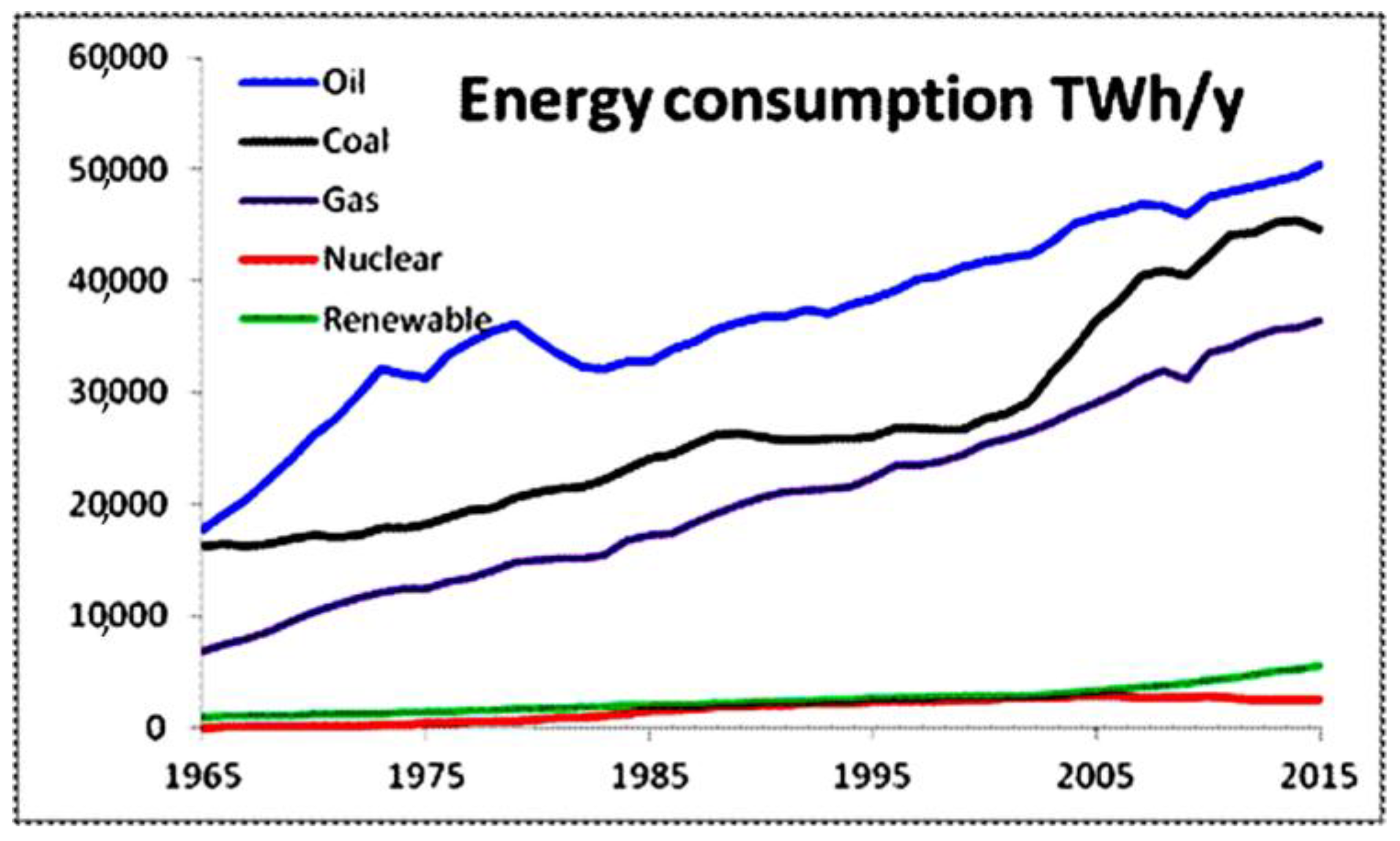
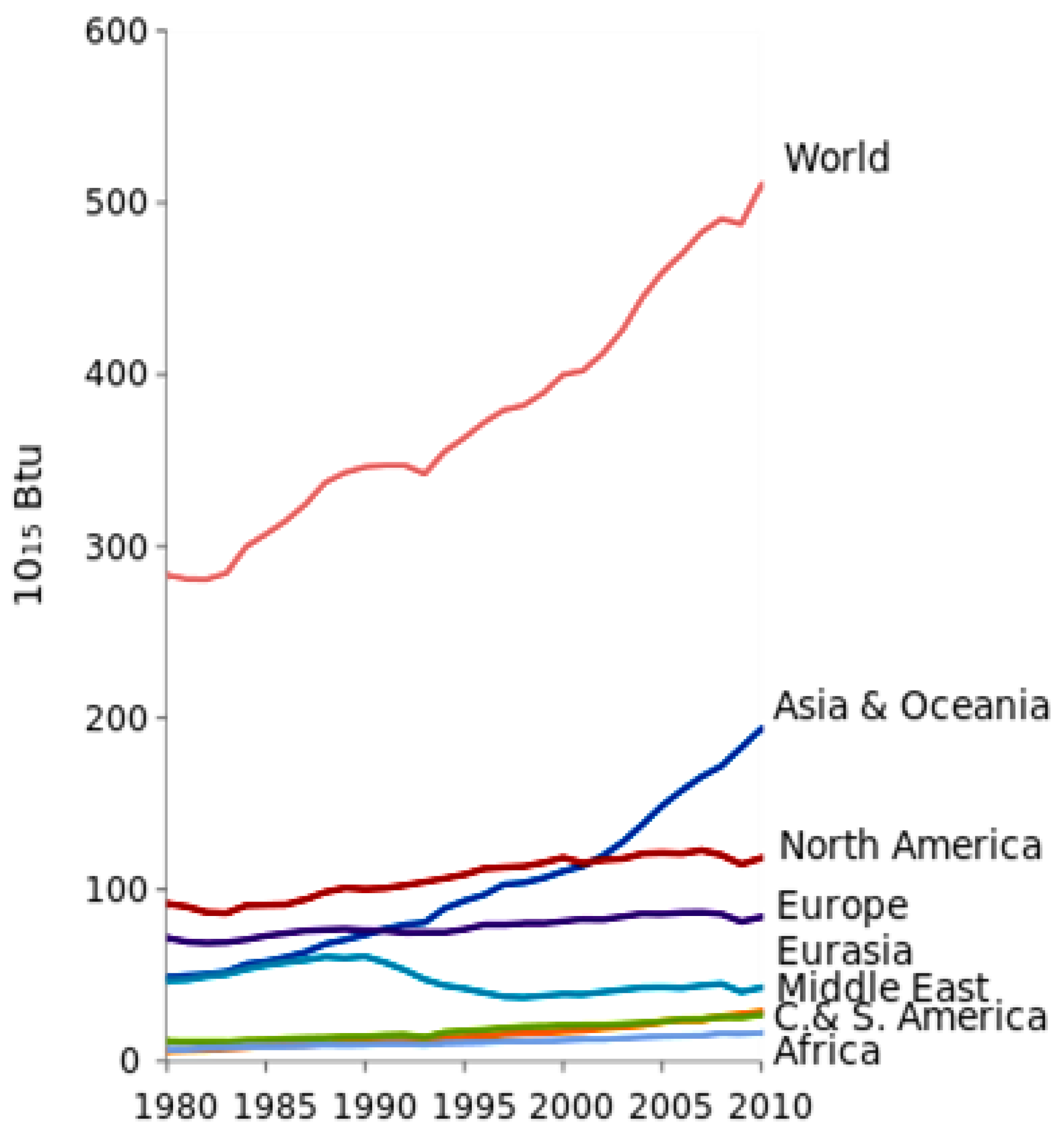
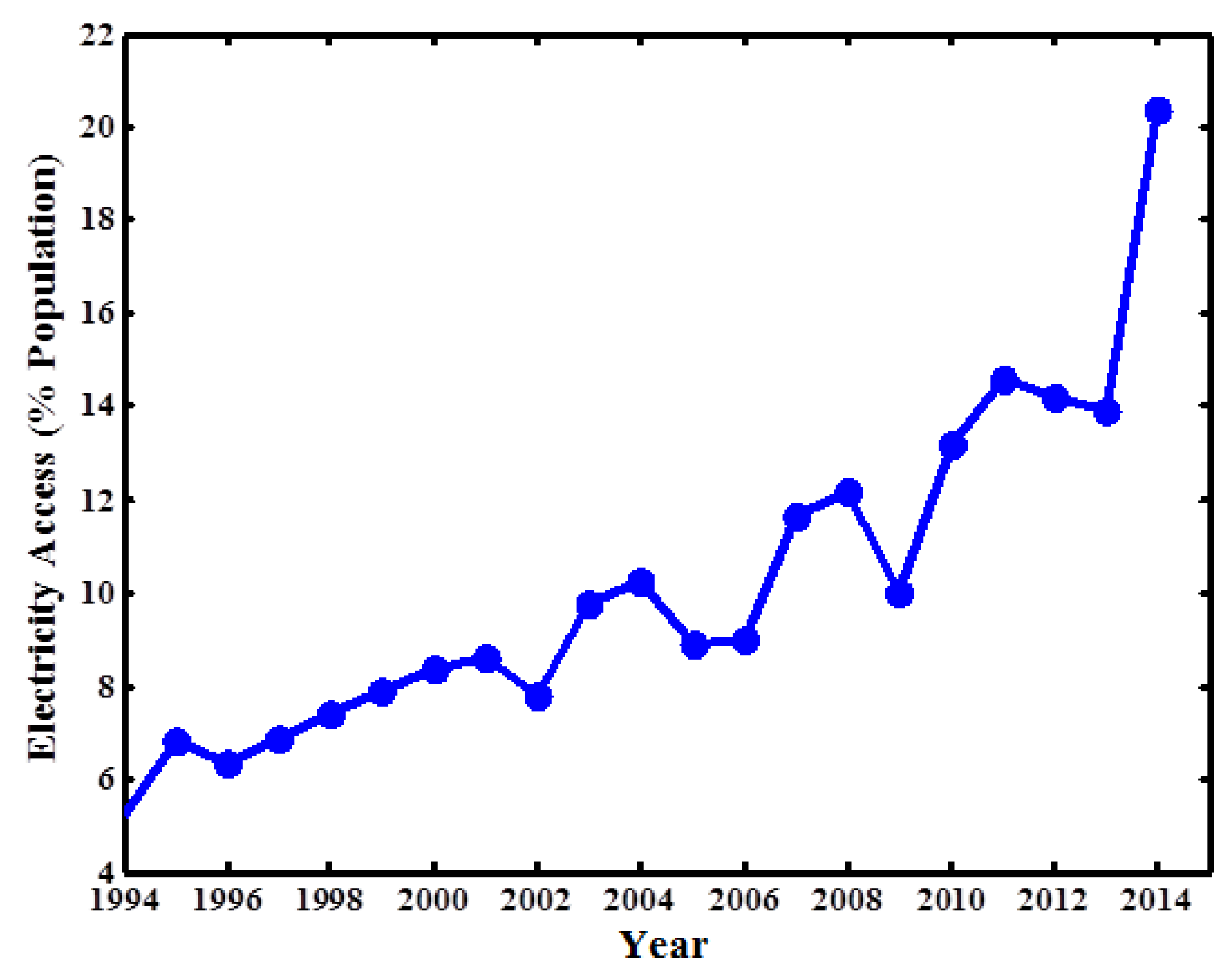
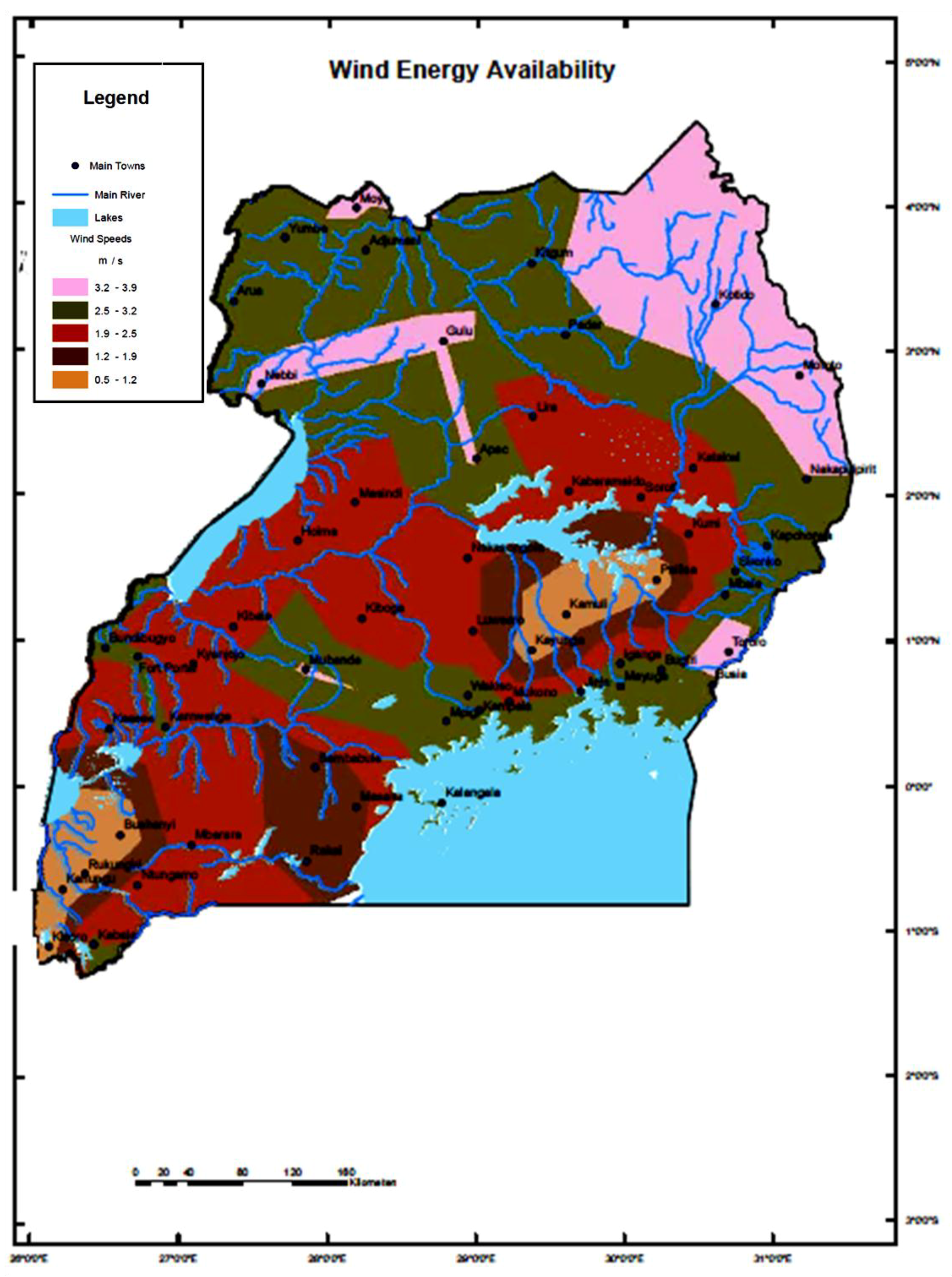
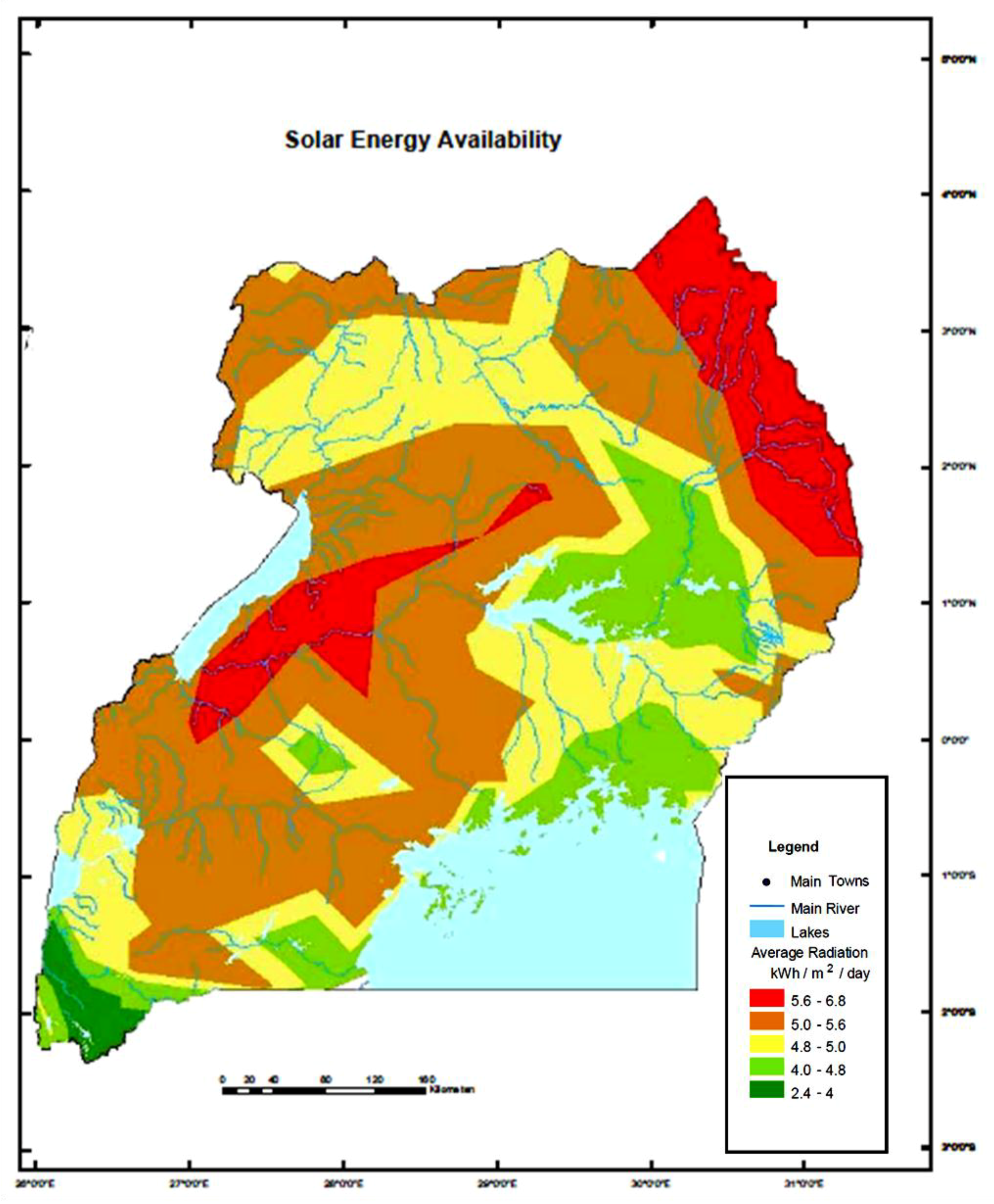
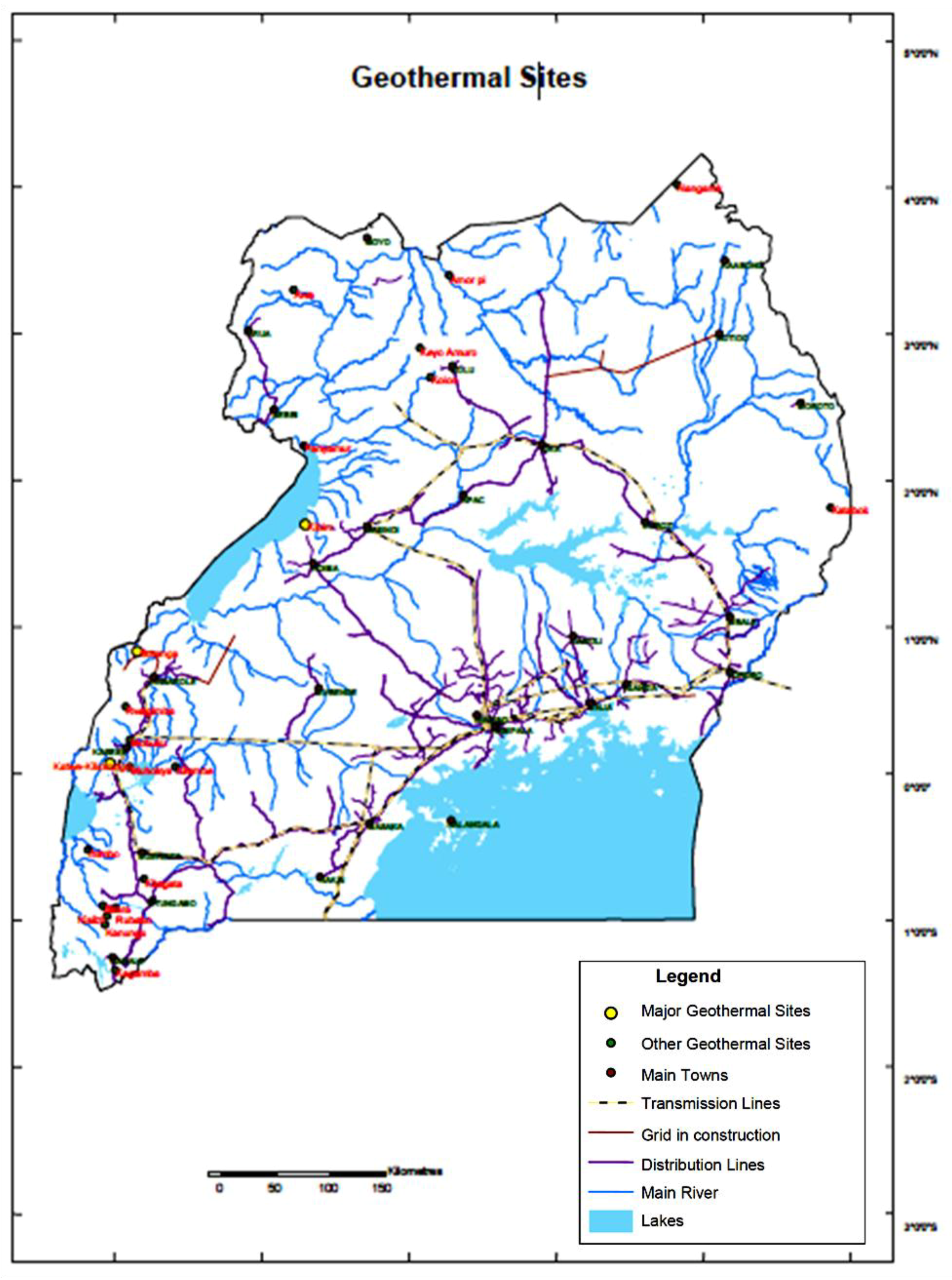

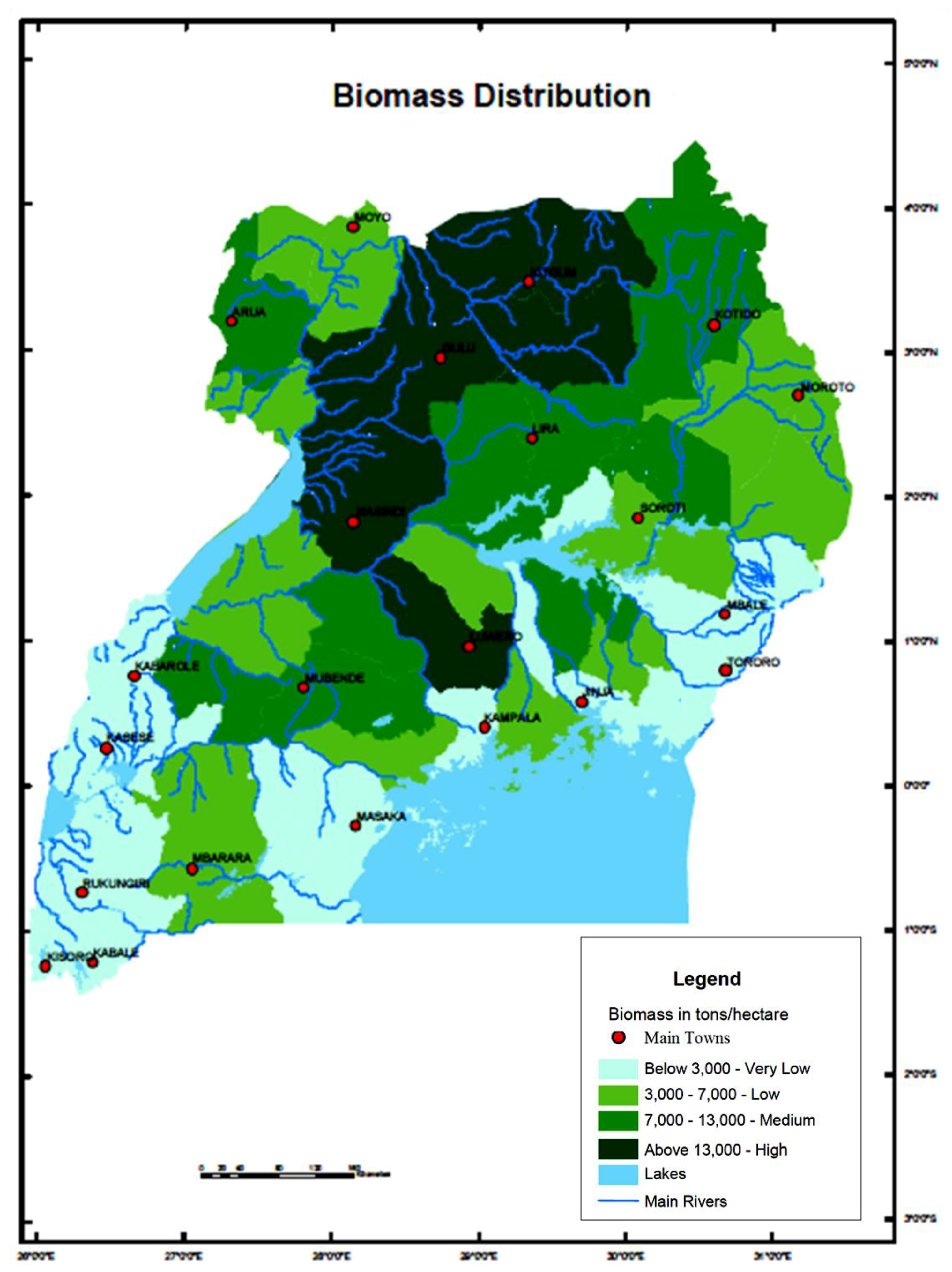
| Energy Source | Estimated Electrical Potential (MW) |
|---|---|
| Hydro | 4137 |
| Geothermal | 450 |
| Biomass cogeneration | 1650 |
| Solar | 200 |
| Peat | 800 |
| Wind | Yet to be determined |
| Total | 7237 |
| Plant/Source | Capacity (MW) |
|---|---|
| Kiira (large hydropower station) | 200 |
| Nalubaale (large hydropower station) | 180 |
| Bujagali (large hydropower station) | 250 |
| Jacobsen Namanve (thermal power plant) | 50 |
| Electro-Maxx-Tororo (thermal power plant) | 50 |
| Kakira Sugar Works Ltd. (cogeneration) | 22 |
| Kinyara Sugar Works (cogeneration) | 7.5 |
| Kilembe Mines Ltd. (small hydro) | 5 |
| Tronder Power Bugoye (small hydro) | 13 |
| Eco Power Ishasha (small hydro) | 6.5 |
| Africa EMS Mpanga (small hydro) | 18 |
| Hydromax Buseruka | 9 |
| Kasese Cobalt Company Ltd. | 10.5 |
| Total | 821.5 |
| Biomass Type | Estimated Annual Production (‘000 Tons/Year) | MWe Average |
|---|---|---|
| Bagasse | 590 | |
| Bagasse surplus (available immediately) | 50 | 67 |
| Rice husks | 3 × 25-35 | 16 |
| Rice straw | 45-55 | 30 |
| Sunflower hulls | 17 | 20 |
| Cotton seed hulls | +50 (being developed) | 1 |
| Tobacco dust | 2-4 | 2 |
| Maize cobs | 234 | 139 |
| Coffee husks | 160 | 95 |
| Groundnut shells | 63 | 37 |
| Total | 407 | |
© 2018 by the authors. Licensee MDPI, Basel, Switzerland. This article is an open access article distributed under the terms and conditions of the Creative Commons Attribution (CC BY) license (http://creativecommons.org/licenses/by/4.0/).
Share and Cite
Fashina, A.; Mundu, M.; Akiyode, O.; Abdullah, L.; Sanni, D.; Ounyesiga, L. The Drivers and Barriers of Renewable Energy Applications and Development in Uganda: A Review. Clean Technol. 2019, 1, 9-39. https://doi.org/10.3390/cleantechnol1010003
Fashina A, Mundu M, Akiyode O, Abdullah L, Sanni D, Ounyesiga L. The Drivers and Barriers of Renewable Energy Applications and Development in Uganda: A Review. Clean Technologies. 2019; 1(1):9-39. https://doi.org/10.3390/cleantechnol1010003
Chicago/Turabian StyleFashina, Adebayo, Mustafa Mundu, Oluwole Akiyode, Lookman Abdullah, Dahiru Sanni, and Living Ounyesiga. 2019. "The Drivers and Barriers of Renewable Energy Applications and Development in Uganda: A Review" Clean Technologies 1, no. 1: 9-39. https://doi.org/10.3390/cleantechnol1010003
APA StyleFashina, A., Mundu, M., Akiyode, O., Abdullah, L., Sanni, D., & Ounyesiga, L. (2019). The Drivers and Barriers of Renewable Energy Applications and Development in Uganda: A Review. Clean Technologies, 1(1), 9-39. https://doi.org/10.3390/cleantechnol1010003





